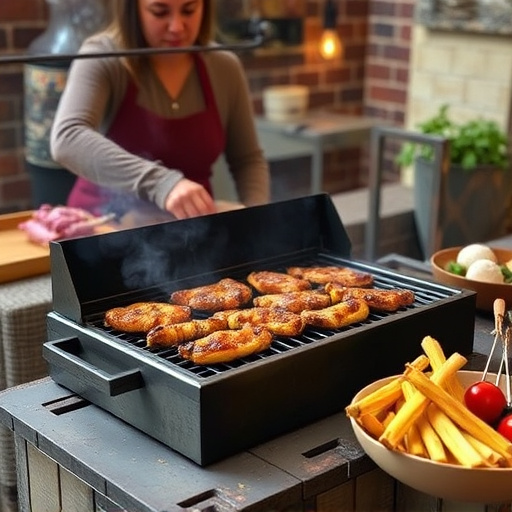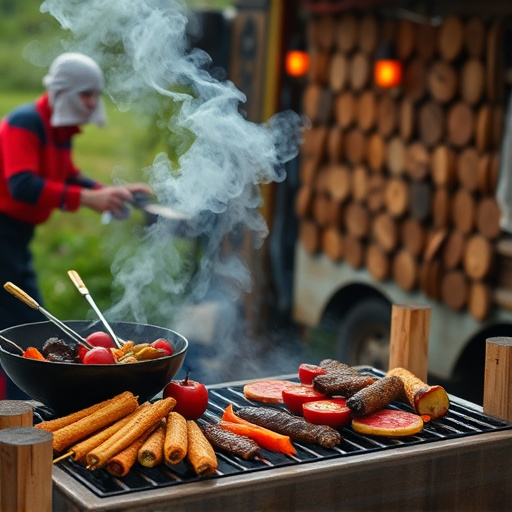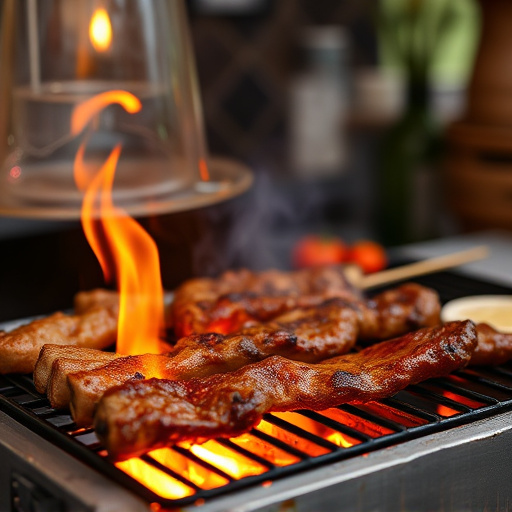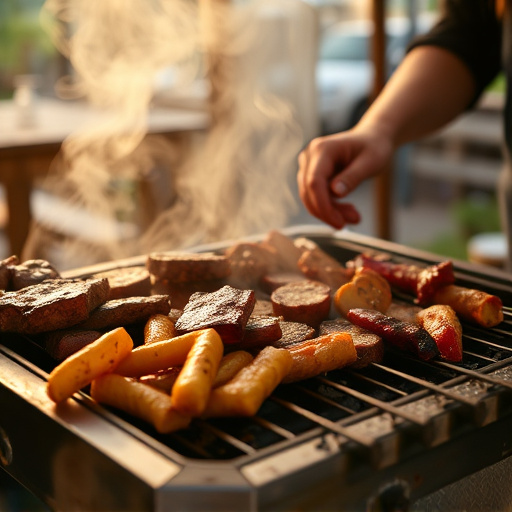To create a perfect BBQ pork tenderloin, start with high-quality, well-marbled center-cut meat (1.5 inches in diameter) from a grass-fed pig. Choose between a whole tenderloin or 'double-cut' slices for enhanced tenderness and marinating potential. Trim excess fat, make diagonal cuts, and dry-brine the meat overnight for optimal juiciness and flavor. Finish with a flavorful marinade to break down connective tissues and create a mouthwatering BBQ pork tenderloin recipe.
Unleash the mouthwatering delight of fall-off-the-bone tender pork barbecue with this comprehensive guide! Discover the secrets behind achieving culinary perfection with our step-by-step recipe. From selecting the perfect cut – understanding various pork tenderloin types and factors – to mastering preparation techniques for unparalleled tenderness, we’ve got you covered. Learn how to craft a flavor-packed BBQ sauce and choose between grilling or smoking for the best results. Plus, get expert tips on timing, temperature, and serving suggestions to create a memorable BBQ experience.
- Choosing the Right Pork Tenderloin
- – Types of pork tenderloin available
- – Factors to consider when selecting
- Preparation Techniques for Optimal Tenderness
- – Dry-brining vs wet brining
- – Marinades and their impact on tenderness
Choosing the Right Pork Tenderloin

When it comes to a fall-off-the-bone BBQ pork tenderloin recipe, the quality of your meat is paramount. Choosing the right cut ensures that your final dish lives up to its promise of tender, juicy goodness. Opt for a center-cut pork tenderloin, which is leaner and more likely to stay moist during slow cooking. This cut is also free from silky muscle fibers, resulting in a melt-in-your-mouth texture that’s characteristic of the best BBQ pork.
Look for a tenderloin with uniform marbling—the fat streaks throughout the meat—as this adds flavor and moisture. A good rule of thumb is to choose a tenderloin that’s about 1.5 inches (3.8 cm) in diameter at its widest point. This ensures even cooking and prevents overcooking in spots, leading to a more consistent and delicious BBQ pork tenderloin recipe result.
– Types of pork tenderloin available

When it comes to choosing the perfect cut for your fall-off-the-bone BBQ pork tenderloin recipe, there are two primary types to consider. The first is the classic, straight-from-the-butcher pork tenderloin—a long, slender muscle with minimal fat, known for its tender texture and versatile flavor. This option is ideal for slow-roasting or grilling, allowing the natural juices to permeate every fiber, resulting in a melt-in-your-mouth delicacy.
Alternatively, look for pork tenderloins that have been ‘double-cut’ or ‘butterflied’. These cuts involve slicing the tenderloin down its length, flattening it slightly, and then cutting through the muscle fibers to create parallel strips. This method not only makes the meat incredibly tender but also allows for better marinating and basting during the BBQ process, enhancing the overall flavor profile of your barbecue pork tenderloin recipe.
– Factors to consider when selecting

When it comes to choosing the perfect cut for a mouth-watering BBQ pork tenderloin recipe, several factors come into play. Look for a well-marbled tenderloin with a good fat content; this ensures that your meat stays moist and tender during the slow cooking process. The ideal weight is around 2-3 pounds, allowing for juicy, flavorful slices. Quality is key; opt for a good grade of pork, preferably grass-fed, to enhance the overall taste.
Consider the cutting method as well; ask your butcher to cut the tenderloin into even rounds or wedges to ensure even cooking and a consistent texture. This simple step can make a significant difference in the final dish’s appeal and digestibility. Remember, the right selection of ingredients sets the stage for a truly exceptional BBQ pork tenderloin recipe, so take your time to find the best fit for your culinary needs.
Preparation Techniques for Optimal Tenderness

When preparing a fall-off-the-bone tender pork barbecue recipe, especially for a BBQ pork tenderloin, several techniques can ensure optimal tenderness. The first step is to choose the right cut—look for a tenderloin with a good marbling of fat, as this will keep the meat moist during cooking. After trimming any excess fat or silver skin, use a sharp knife to make diagonal cuts along the length of the meat; this helps to break down tough fibers, leading to a more tender final product.
Pre-cooking methods like drying the meat (patting it dry with paper towels) and seasoning generously with salt and pepper can significantly enhance tenderness. Dry heat causes the collagen in the meat to convert into gelatin, making it incredibly soft. Additionally, slow cooking at low temperatures allows for a deeper penetration of flavors without overcooking the pork, ensuring it remains juicy and tender.
– Dry-brining vs wet brining

When preparing a mouthwatering BBQ pork tenderloin recipe, the brining process is key to achieving that fall-off-the-bone tenderness. There are two primary methods: dry-brining and wet brining. Dry-brining involves coating the meat with a mixture of coarse salt and spices, allowing it to absorb moisture from the air. This method is popular for pork because it helps draw out fats and juices, resulting in incredibly tender meat. On the other hand, wet brining uses a solution of salt and water, sometimes with added ingredients like sugar or herbs, which creates a more intense flavor profile. While effective, wet brining can make the meat slightly softer due to the added moisture. For a classic BBQ pork tenderloin experience, many chefs prefer the dry-brine method, as it enhances the natural flavors without overpowering them, making your barbecue efforts truly unforgettable.
– Marinades and their impact on tenderness

Marinades are a secret weapon for achieving fall-off-the-bone tender BBQ pork. They penetrate the meat’s fibers, breaking down tough connective tissues and collagen, resulting in incredibly succulent and juicy slices. When it comes to a bbq pork tenderloin recipe, marinating is key to transforming the lean cut into something truly special.
Choosing the right marinade brings out the best flavors of the pork, enhancing its natural sweetness with a range of options from tangy and herby to smoky and spicy. Whether you opt for a classic vinegar-based marinade or a more complex blend of sauces and spices, the process of soaking the meat for several hours—or even overnight—makes all the difference in achieving that coveted tender texture.
